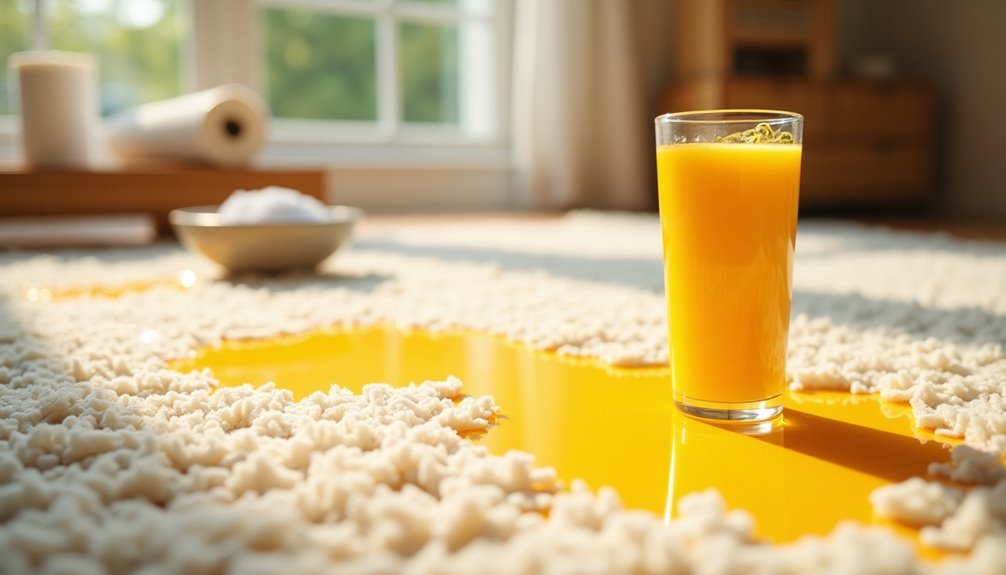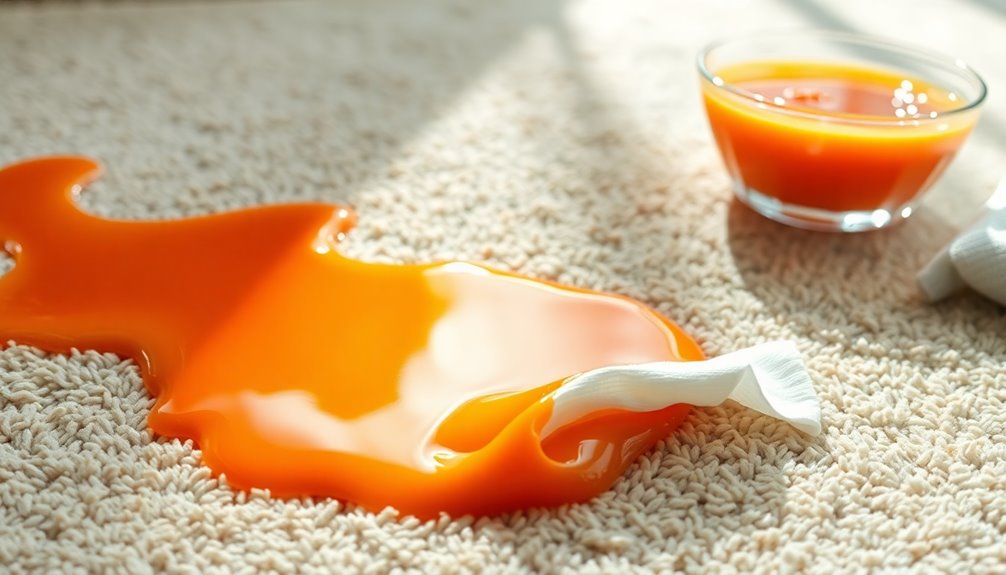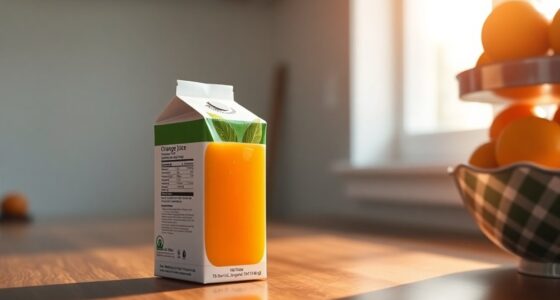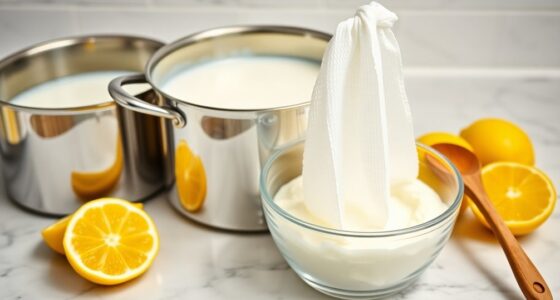To get orange juice out of your carpet, act fast! Blot the stain immediately with a clean towel to absorb excess liquid. For fresh stains, mix two cups of warm water with a tablespoon of dishwashing detergent and gently blot the affected area. If the stain is older, use a solution of warm water and ammonia instead. Rinse with cold water afterward. If the stain persists, there are more options you can explore for effective removal.
Key Takeaways
- Blot the orange juice stain immediately with a clean towel to absorb excess liquid and prevent deeper staining.
- For fresh stains, use a solution of warm water and dishwashing detergent; gently blot from the outside toward the center.
- For older stains, moisten the area, then apply a cleaning solution of warm water and ammonia, continuing to blot until the stain improves.
- Rinse the area afterward with cold water using a clean cloth to remove any leftover cleaning solution and residue.
- If the stain persists, consider seeking professional cleaning services for effective and eco-friendly stain removal.

If you spill orange juice on your carpet, don't panic—quick action can make a big difference. The first step is to grab a clean towel or paper towel and start to blot the stain immediately. It's crucial to absorb as much liquid as possible before it seeps deeper into the carpet fibers. Keep dabbing at the stain until no more juice is coming up. The longer you wait, the harder it'll be to remove orange juice stains, so don't hesitate to act.
Once you've blotted up the excess juice, it's time to prepare a cleaning solution. Mix two cups of warm water with one tablespoon of dishwashing detergent. This combination can work wonders on fresh stains. Using a clean cloth, dab the solution onto the stain, but avoid scrubbing. Scrubbing can damage the carpet fibers and spread the stain further. Instead, gently blot the area, working from the outside of the stain towards the center to prevent it from spreading.
If the stain has already set in and is a bit older, you'll need a different approach. Moisten the stained area with lukewarm water first. Then, create an effective cleaning solution by mixing two cups of warm water with ammonia. Apply this solution carefully, again using a clean cloth to blot the stain. Patience is key here; keep blotting until you notice the stain lifting. It may take a few repetitions, but with persistence, you should see improvement.
After you've successfully lifted the stain, it's essential to rinse the area. Use a clean cloth or paper towel dipped in cold water to wipe away any remaining detergent or cleaning solution. This step prevents residue buildup that could attract dirt or lead to future staining. Gently blot the area until it's clean, then let it air dry completely.
Sometimes, despite your best efforts, the stain can be stubborn, especially if it's from an older spill or if your carpet is made from delicate materials. If your attempts to remove orange juice stains haven't been successful, it might be time to consider professional cleaning services.
Professionals have specialized tools and eco-friendly solutions that can tackle tough stains without damaging your carpet. They can often reach deep into the fibers, ensuring a thorough clean that you mightn't be able to achieve at home.
Frequently Asked Questions
Can You Get Orange Juice Stains Out of Carpet?
Yes, you can get orange juice stains out of carpet if you act quickly.
Start by blotting the stain with a clean cloth to absorb excess liquid.
Then, mix warm water with dish soap or white vinegar, and gently apply it to the area.
Avoid scrubbing, as it can damage the fibers.
For stubborn stains, consider using an ammonia solution, but always rinse with cold water afterward to prevent residue.
Do Orange Juice Stains Come Out?
Yes, orange juice stains can come out, especially if you act quickly.
When you treat fresh stains right away, you've got a better chance of complete removal. Use a solution of vinegar or dish soap to lift the stain without damaging your carpet.
Remember to blot the area gently instead of scrubbing, as scrubbing can spread the stain.
For older stains, you might need more powerful cleaning methods or professional help.
Does Juice Come Out of Carpet?
When it comes to juice stains on carpet, you can certainly turn things around if you act fast.
Fresh juice stains usually come out easily, so grab a cloth and blot the area immediately.
If the stain's set in, using a warm water and detergent mix can help break it down.
For tougher stains, you might need something stronger.
Just remember, the sooner you tackle it, the better your chances of success!
How to Get Orange Juice Smell Out of Carpet?
To get rid of that pesky smell from your carpet, you can start by mixing equal parts of white vinegar and water in a spray bottle.
Lightly mist the affected area and blot with a clean cloth.
Afterward, sprinkle baking soda over the damp spot to absorb any lingering odors.
If the smell persists, try an enzymatic cleaner, following the product instructions for the best outcome.
Don't forget to ventilate the area for fresh air!
Conclusion
Getting orange juice out of your carpet may feel like fighting a stubborn stain monster, but with the right approach, you can conquer it. By acting quickly and using the right cleaning solutions, you can restore your carpet to its former glory. Remember, persistence is key, and don't be afraid to repeat steps if necessary. With a little patience and effort, you'll have that vibrant carpet looking fresh and clean again, ready to face whatever spills come next.
Cindy thoroughly researches juicing trends, techniques, and recipes to provide readers with practical advice and inspiration. Her writing style is accessible, engaging, and designed to make complex concepts easy to understand. Cindy’s dedication to promoting the advantages of juicing shines through her work, empowering readers to make positive changes in their lives through the simple act of juicing.











